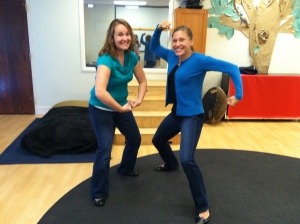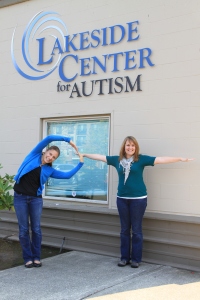Welcome to National Occupational Therapy Month! This March, we will emphasize the following skill areas each week:
WEEK 1: Activities of Daily Living
WEEK 2: Fine Motor
WEEK 3: Sensory Processing
WEEK 4: Play
…so stay tuned for our weekly blog posts with tips and activities to promote each OT skill area!
Continue reading to learn more about our OTs and why they do what they do!…
Question #1: Why did you become an OT?
Nicole: I have always known I wanted to work with children in some capacity, but choosing a particular field proved challenging. I was introduced to occupational therapy through a member of my family, and I quickly developed an interest in the field. Occupational therapy sparked my interest because of its broad array of domains and areas of occupation, as it offers unlimited possibilities to people of all ages. I wanted to play a part in enabling individuals to live life to the fullest.
Kavita: I’ve always wanted to work with young kids with disabilities. My mother was a preschool special education teacher and I have fond memories of being a peer model in her class when I was younger, and volunteering as an aide when I was older. I was first introduced to OT when I volunteered in high school at CCS (California Children’s Services). The OTs made a huge difference in the quality of life for so many kids and I knew that was what I wanted to do too!
Jill: I became an OT because I wanted to help people in a way that was meaningful.
Erica: I decided to become an OT as an undergraduate Child Development major first and foremost because I love kids. I have worked with children with and without disabilities since I can remember, and love that I was able to make a career out of it!
Shana: I have always known that I wanted to work with children. When I was in elementary school I wanted to be a teacher, but as I got a little older I realized that I wanted to work with kids outside of the classroom. I fell in love with Occupational Therapy because I get to help kids achieve goals in every area of their lives. My job is to help kids learn to be kids. How cool is that?!?!
Question #2: What is your favorite thing about being an OT?
Nicole: During my field work in graduate school, I was given the opportunity to visit a variety of different occupational therapy settings; I immediately fell in love with my pediatric setting. Learning and teaching that play is the occupation for children was a revolution in my mind, and I could think of nothing better than to make pediatric occupational therapy my profession. I love the experience of watching a child grow, be it through writing his/her name, tying a shoe, eating a vegetable, or playing with a peer. I have learned that “play” can be challenging with children, but I look forward to each moment, and treasure the opportunity to be spontaneous and creative. I enjoy the everyday challenges of thinking outside of the box and connecting with my inner child! Not every person can say, “I had fun at work today,” but I can every single day!
Kavita: The occupation of being a child consists of exploring the world, playing, and becoming more independent. I love participating with children as they grow in these areas. Even though some days may be difficult, the overall progress that children and their families make is the most rewarding aspect of my job.
Jill: My favorite thing about being an OT is that I can be creative and really see a person as a whole. I love that I not only work on the physical being but the emotional being and how they interact with their environment.
Erica: I like that I get to work with children and with families. I love that I get to play at work and that kids can work on their goals through activities that they enjoy. I also like to see the amazing progress that kids make, and those moments where it finally ‘clicks’ after weeks and months of trying a new skill!
Shana: There is nothing better than seeing a child’s face when her or she is able to a new skill completely by themself for the very first time. The pride and excitement that comes with independence is so empowering for kids.
Question #3: What are your go to OT words of wisdom?
Nicole: Play provides us with an endless opportunity to grow, learn, and experience our surroundings. It’s through play in which we learn about ourselves and our environment. There is no better time than the present to encourage new experiences so get out and explore.
Kavita: As therapists and parents, it is difficult to see kids fail or struggle. It’s important to remember that some of the best lessons are learned through mistakes. Let your child try their own way and be there when they need you for guidance. When children try, fail, and try again, they become independent problem solvers.
Jill: For parents, keep focusing on the positives no matter how small or large. The hard times will come but in order to move forward it is important to always remember and celebrate the wins! For providers, don’t be afraid to have fun. We are always striving to reach goals and help families, but the road will be a lot longer if we don’t stop to enjoy our clients and families that we support.
Erica: Play is more of the most important and essential functions of childhood. According to AOTA, “It is a child’s ‘job’ or ‘occupation’ to play to develop physical coordination, emotional maturity, social skills to interact with other children, and self-confidence to try new experiences and explore new environments.” That’s why it is so important to find the time, even if it’s just for a couple minutes, to get on the floor and engage in some unstructured play with your child. Follow your child’s lead, help him/her expand on his/her play ideas by adding in a new element, and just get silly!
Shana: A kid’s job is to be a kid. They need to finish their homework and their chores. They need to be able to tie their shoes and brush their teeth. But, most importantly they need to be able to have fun. Run around on the playground and play a board game with friends. And at the end of the day enjoying a big bear hug from a loved one!
Posted by: Your Lakeside OTs – Nicole, Kavita, Jill, Erica & Shana.









